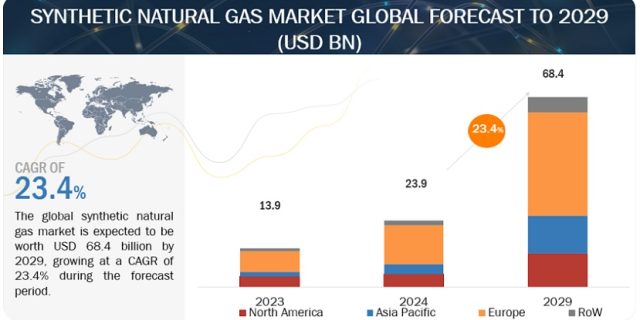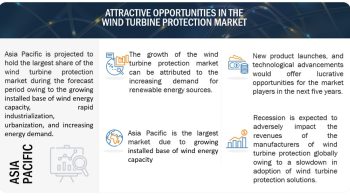
The global Synthetic Natural Gas Market in terms of revenue was estimated to be worth $23.9 billion in 2024 and is poised to reach $68.4 billion by 2029, growing at a CAGR of 23.4% from 2024 to 2029 according to a new report by MarketsandMarkets™.
The global Synthetic Natural Gas Market is anticipated to grow at a higher level. There are various drivers responsible for the growth of the market such as government policies and incentives and technological advancements among others. Investments in infrastructure for gasification, methanation, and distribution networks constitute the backbone of the synthetic natural gas (SNG) market. This strategic allocation of resources is pivotal for ensuring the seamless production and widespread adoption of SNG as a viable energy source. Technological advancements enable the creation of more dependable and cost-effective synthetic natural gas technologies, hence propelling market expansion.
Download an Illustrative overview: https://www.marketsandmarkets.com/pdfdownloadNew.asp?id=30021783
Public perception plays a crucial role in shaping the trajectory of coal-derived SNG projects. Concerns about air pollution, climate change, and sustainability have led to heightened scrutiny of fossil fuel-based energy sources, including coal. Negative perceptions of coal’s environmental impact, such as its contribution to greenhouse gas emissions and its association with local air pollution and health issues, can lead to opposition from communities, environmental groups, and policymakers.
Furthermore, public perception can affect the market demand for SNG produced from coal by influencing consumer preferences, investor decisions, and corporate sustainability goals. Companies operating in industries sensitive to public opinion, such as utilities and energy providers, may face reputational risks and market backlash if they are perceived as supporting or investing in coal-derived SNG projects without adequate environmental mitigation measures.
The Anaerobic digestion & fermentation technology is expected to be the largest segment in the synthetic natural gas market.
Waste management needs are increasingly pressing in modern societies, particularly concerning the management of organic waste. Anaerobic digestion and fermentation technology present a compelling solution to this challenge by efficiently converting organic waste into energy. As urban populations grow and consumption patterns evolve, the volume of organic waste generated continues to rise, placing strain on traditional waste management systems. Inefficient disposal of organic waste not only contributes to environmental pollution but also represents a significant missed opportunity for resource recovery.
Asia Pacific is expected to be the fastest growing region in the synthetic natural gas market.
Robust economic growth in the Asia Pacific region drives increased energy consumption across various sectors, including industry, transportation, and residential. As economies expand, there is a greater demand for energy, including cleaner alternatives like SNG, to fuel industrial processes, power generation, and transportation networks. Rapid urbanization, population growth, and increasing per capita income levels in many Asia Pacific countries drive up overall energy demand. This trend is particularly pronounced in emerging economies experiencing a surge in industrialization and infrastructure development. Consequently, there is a heightened focus on diversifying the energy mix and securing sustainable sources of energy, including SNG, to meet the growing needs of a burgeoning population and expanding economies.
Request Sample Pages: https://www.marketsandmarkets.com/requestsampleNew.asp?id=30021783
Key Market Players of Synthetic Natural Gas Industry:
Some of the major players in the Synthetic Natural Gas Market are Basin Electric Power Cooperative (US), Air Liquide (France), EnviTec Biogas AG (Germany), Verbio SE (Germany), Kinder Morgan (US). The major strategies adopted by these players include new product launches, acquisitions, contracts, agreements, partnerships, joint ventures, collaborations, investments, and expansions.


